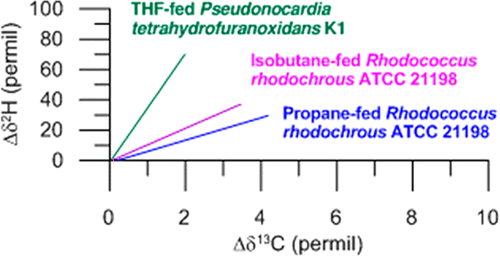当前位置:
X-MOL 学术
›
Environ. Sci. Technol. Lett.
›
论文详情
Our official English website, www.x-mol.net, welcomes your
feedback! (Note: you will need to create a separate account there.)
Enrichment with Carbon-13 and Deuterium during Monooxygenase-Mediated Biodegradation of 1,4-Dioxane
Environmental Science & Technology Letters ( IF 8.9 ) Pub Date : 2018-02-15 00:00:00 , DOI: 10.1021/acs.estlett.7b00565 Peter Bennett 1 , Michael Hyman 2 , Christy Smith 2 , Humam El Mugammar 3 , Min-Ying Chu 4 , Michael Nickelsen 5 , Ramon Aravena 6
Environmental Science & Technology Letters ( IF 8.9 ) Pub Date : 2018-02-15 00:00:00 , DOI: 10.1021/acs.estlett.7b00565 Peter Bennett 1 , Michael Hyman 2 , Christy Smith 2 , Humam El Mugammar 3 , Min-Ying Chu 4 , Michael Nickelsen 5 , Ramon Aravena 6
Affiliation

|
Recent technical developments have enabled the application of compound-specific isotope analysis (CSIA) of low (parts per billion) concentrations of 1,4-dioxane that are often found in groundwater at 1,4-dioxane-contaminated sites. However, to quantify 1,4-dioxane biodegradation, isotopic enrichment factors are needed to interpret the CSIA data obtained from field samples. In this study, the carbon and hydrogen isotopic enrichment factors (εC and εH, respectively) for 1,4-dioxane biodegradation have been determined for axenic propane- or isobutane-grown cultures of Rhodococcus rhodochrous ATCC 21198 and for tetrahydrofuran-grown cultures of Pseudonocardia tetrahydrofuranoxidans K1. The enrichment factors for propane-grown (εC = −2.7 ± 0.3‰, and εH = −21 ± 2‰) and isobutane-grown (εC = −2.5 ± 0.3‰, and εH = −28 ± 6‰) cells of strain 21198 were similar and substantially smaller than those determined for tetrahydrofuran-grown cells of strain K1 (εC = −4.7 ± 0.9‰, and εH = −147 ± 22‰). The presence of 1-butyne consistently inhibited both the biodegradation and isotopic fractionation of 1,4-dioxane, and this effect implicates monooxygenase enzymes in both the biodegradation and isotopic enrichment of 1,4-dioxane. Our results confirm that an increasing level of enrichment of heavier isotopes of carbon and hydrogen can be used to quantify 1,4-dioxane biodegradation and suggest CSIA can discriminate between the activities of monooxygenase-expressing bacteria expected to be prevalent in engineered, gaseous alkane-stimulated 1,4-dioxane treatment systems and those that may involve microbial metabolism of 1,4-dioxane as a natural attenuation process.
中文翻译:

单加氧酶介导的1,4-二恶烷生物降解过程中碳13和氘的富集
最近的技术发展使得能够对低浓度(十亿分之一)的1,4-二恶烷进行化合物特异性同位素分析(CSIA),这种现象通常在受1,4-二恶烷污染的地下水中发现。但是,为了定量1,4-二恶烷的生物降解,需要同位素富集因子来解释从田间样品获得的CSIA数据。在这项研究中,碳和氢的同位素富集因子(ε ç和ε ħ,分别地)用于1,4-二恶烷的生物降解已被确定为无菌丙烷或异丁烷生长培养玫瑰色红球菌ATCC 21198和四氢呋喃生长培养的假tetrahydrofuranoxidans K1。丙烷生长的富集因子(εÇ = -2.7±0.3‰,ε ħ = -21±2‰)和异丁烷生长(ε c ^ = -2.5±0.3‰,ε ħ = -28±6‰)菌株21198的细胞进行类似的,并且基本上比那些应变K1(ε的四氢呋喃生长的细胞来确定更小的C ^ = -4.7±0.9‰,ε ħ= −147±22‰)。1-丁炔的存在始终抑制1,4-二恶烷的生物降解和同位素分馏,并且这种作用暗示单加氧酶参与1,4-二恶烷的生物降解和同位素富集。我们的结果证实,碳和氢的较重同位素的富集程度不断提高,可用于量化1,4-二恶烷的生物降解,并表明CSIA可以区分预期在工程气态烷烃中普遍存在的表达单加氧酶的细菌的活性。刺激的1,4-二恶烷处理系统以及可能涉及1,4-二恶烷微生物代谢的自然衰减过程的系统。
更新日期:2018-02-16
中文翻译:

单加氧酶介导的1,4-二恶烷生物降解过程中碳13和氘的富集
最近的技术发展使得能够对低浓度(十亿分之一)的1,4-二恶烷进行化合物特异性同位素分析(CSIA),这种现象通常在受1,4-二恶烷污染的地下水中发现。但是,为了定量1,4-二恶烷的生物降解,需要同位素富集因子来解释从田间样品获得的CSIA数据。在这项研究中,碳和氢的同位素富集因子(ε ç和ε ħ,分别地)用于1,4-二恶烷的生物降解已被确定为无菌丙烷或异丁烷生长培养玫瑰色红球菌ATCC 21198和四氢呋喃生长培养的假tetrahydrofuranoxidans K1。丙烷生长的富集因子(εÇ = -2.7±0.3‰,ε ħ = -21±2‰)和异丁烷生长(ε c ^ = -2.5±0.3‰,ε ħ = -28±6‰)菌株21198的细胞进行类似的,并且基本上比那些应变K1(ε的四氢呋喃生长的细胞来确定更小的C ^ = -4.7±0.9‰,ε ħ= −147±22‰)。1-丁炔的存在始终抑制1,4-二恶烷的生物降解和同位素分馏,并且这种作用暗示单加氧酶参与1,4-二恶烷的生物降解和同位素富集。我们的结果证实,碳和氢的较重同位素的富集程度不断提高,可用于量化1,4-二恶烷的生物降解,并表明CSIA可以区分预期在工程气态烷烃中普遍存在的表达单加氧酶的细菌的活性。刺激的1,4-二恶烷处理系统以及可能涉及1,4-二恶烷微生物代谢的自然衰减过程的系统。











































 京公网安备 11010802027423号
京公网安备 11010802027423号